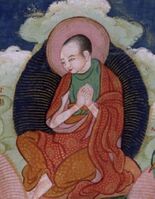Dge slong ma dpal mo: Difference between revisions
No edit summary |
No edit summary |
||
| (8 intermediate revisions by 2 users not shown) | |||
| Line 1: | Line 1: | ||
{{Person | {{Person | ||
| | |HasDrlPage=Yes | ||
|HasLibPage=Yes | |||
|HasRtzPage=Yes | |||
|MainNamePhon=Gelongma Palmo | |||
|MainNameTib=དགེ་སློང་མ་དཔལ་མོ་ | |MainNameTib=དགེ་སློང་མ་དཔལ་མོ་ | ||
|MainNameWylie=dge slong ma dpal mo | |MainNameWylie=dge slong ma dpal mo | ||
|MainNameSkt= | |MainNameDev=भिक्षुणीलक्ष्मी | ||
| | |MainNameSkt=Bhikṣuṇī Lakṣmī | ||
|bio=Bhikṣuṇī Lakṣmī, or Gelongma Palmo as she is known in the Tibetan world, was the originator of the practice of nyungne (''smyung gnas''). While some Tibetan sources identify her as a princess of Oḍḍiyana who later became a nun, the Adinath temple in the small hilltop village of Chobhar on the outskirts of Kathmandu is believed to have been either her family home or the original site in which she engaged in this practice. Based on the thousand-armed form of the deity Avalokiteśvara, nyungne involves a typically three day cycle of practice that combines long periods of prostrations with intermittent fasting and the strict observance of vows. The practice was developed by Bhikṣuṇī Lakṣmī and through it she is reported to have cured herself of leprosy. The practice continues to be popular among Himalayan Buddhists, especially among older lay people for whom it is often an annual event that they practice collectively in groups. It is also traditional to repeat the three day cycle eight times in a row. | |||
|PersonType=Classical Indian Authors | |||
|images=File:Gelongma Palmo.jpg | |||
|BdrcLink=https://www.tbrc.org/#!rid=P4CZ10542 | |||
|BdrcPnum=4CZ10542 | |||
|YearBirth=11th century | |||
|BornIn=India/Nepal | |BornIn=India/Nepal | ||
|BuNayDefProvComplex=No | |||
|BuNayWheelTurnComplex=No | |||
|BuNayYogaMadhyaComplex=No | |||
|BuNayZhenRangComplex=No | |||
|BuNayVehiclesComplex=No | |||
|BuNayAnalyticMeditComplex=No | |||
|BuNayEmptyLuminComplex=No | |||
|IsInGyatsa=No | |IsInGyatsa=No | ||
}} | }} | ||
Latest revision as of 09:30, 1 October 2021
| PersonType | Category:Classical Indian Authors |
|---|---|
| MainNamePhon | Gelongma Palmo |
| MainNameTib | དགེ་སློང་མ་དཔལ་མོ་ |
| MainNameWylie | dge slong ma dpal mo |
| MainNameDev | भिक्षुणीलक्ष्मी |
| MainNameSkt | Bhikṣuṇī Lakṣmī |
| bio | Bhikṣuṇī Lakṣmī, or Gelongma Palmo as she is known in the Tibetan world, was the originator of the practice of nyungne (smyung gnas). While some Tibetan sources identify her as a princess of Oḍḍiyana who later became a nun, the Adinath temple in the small hilltop village of Chobhar on the outskirts of Kathmandu is believed to have been either her family home or the original site in which she engaged in this practice. Based on the thousand-armed form of the deity Avalokiteśvara, nyungne involves a typically three day cycle of practice that combines long periods of prostrations with intermittent fasting and the strict observance of vows. The practice was developed by Bhikṣuṇī Lakṣmī and through it she is reported to have cured herself of leprosy. The practice continues to be popular among Himalayan Buddhists, especially among older lay people for whom it is often an annual event that they practice collectively in groups. It is also traditional to repeat the three day cycle eight times in a row. |
| YearBirth | 11th century |
| BornIn | India/Nepal |
| BDRC | https://www.tbrc.org/#!rid=P4CZ10542 |
| IsInGyatsa | No |
| Other wikis |
If the page does not yet exist on the remote wiki, you can paste the tag |

